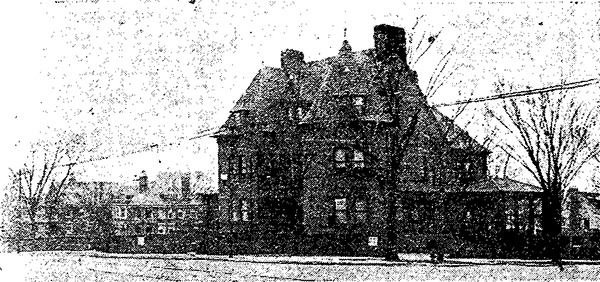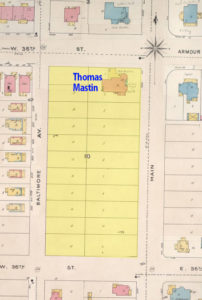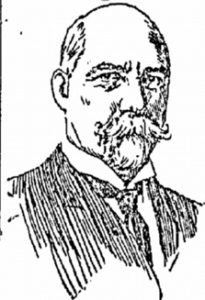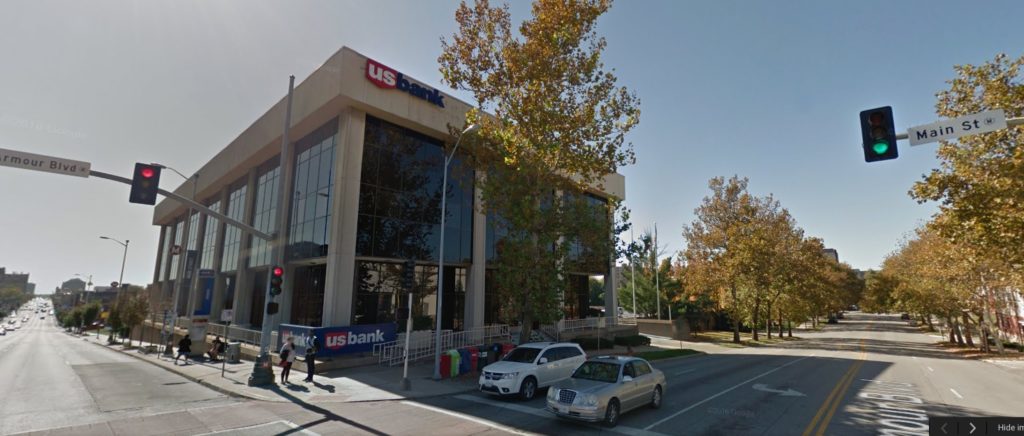
A bank building now sits at the southwest corner of Armour Boulevard and Main Street, offering no hint of the important mansion that once occupied the site. But from the time it was built in 1888 until it was razed in 1927, the Thomas H. Mastin home was one of the best known mansions in Midtown Kansas City.

Stanford White, a well-known New York architect of the era, designed the home for the Mastin. The May 28, 1907 Kansas City Star described the site.
“The Mastin tract has been a beauty spot in Kansas City for years. The grounds are handsomely laid out. There is a well-kept lawn, relieved by shrubbery and plants.”
Thomas Mastin was a Kansas City Pioneer
Before coming to Kansas City as one of its early settlers, Thomas H. Mastin, born in 1840, attended Princteton University and then joined the Confederate Army in Tennessee. He was captured in 1862, but managed to escape in Indiana while being transported back to the north with other soldiers.
Carrie Westlake, in her book Kansas City, Missouri: Its History and Its People 1808-1908, recounts some of the adventures that followed:
“He then exchanged clothes for those worn by a wood chopper and after tramping through the forests for several days he at length reached a small village where he obtained a position as school teacher. Three months later he went to Boston, where he became a driver on a mule car. In that way we worked long enough to pay his passage on a vessel, which was about to run a federal blockade. The vessel sailed for the Bermuda Islands, where Mr. Mastin hoped to secure passage on an English vessel that would take him south. At Bermuda, he became violently ill with yellow fever and did not recover for several months. At length, however, he secured passage on an English ship and in the course of time again reached his regiment. He was especially distinguished in the battles of Shiloh and Chickamauga and at the close of the war was serving on President Davis’ staff with the rank of lieutenant colonel.”

Mastin came to Kansas City in 1866 with his brother, J.J. Mastin, another early Midtown settler. They formed a financial institution, J.J. Mastin and Company, but the bank failed in a 1878 run. Thomas brushed himself off and entered the real estate and mining business, where he recovered his fortunes and became a prominent member of Kansas City business circles.
Thomas Mastin married Elizabeth Harris, daughter of one of the original Westport settlers, in 1868. In 1888, he began building the home on ground that had once been part of the Harris farm.
Mastin also made a big splash in the 1880s when he struck natural gas on his property. Hundreds of people made the trip south to look at the well which was sending up a column of flame. For a while, Mastin was so excited about the gas that he and others discussed plans to lay pipes across Midtown to pipe the gas into homes.
Home Demolished as Main Street Turns Commercial
By the 1920s, the rapid development of Midtown and the popularity of the Main Street streetcar line was rapidly changing Main Street into a commercial, rather than a residential, thoroughfare.
In 1923, Mastin’s heirs sold the home to grocer Fred Wolferman, who built a store on the site. Later a gas station was erected on the site as well. The Mastin home came down in 1927, and Wolferman built a one-story building which he leased to Crown Drug Store for 20 years.
Mastin also sold off the southern section of the block to Charles Campbell, as well-off businessman, who built a famous Midtown home known as White Gables. More about that and the rest of the block in next week’s post.

That a bank now occupies the site of his former home is ironic.
Only imagine what Midtown home values would be worth today had some of these fabulous structures remained and been repurposed as has happened in St Louis’ Central West End. There, much housing like this; often times intermixed with historic business buildings, have been made into multi unit condos, each unit within going for several hundred thousand dollars. Just a thought with regard to bowing to short term business interests and development and disregard for the neighborhood at large. The Burger King now standing on the same intersection as this home pictured above, plus MACs new apartment building next door, with no architectural adherence to historic guidelines, does nothing but chase my home value further down. Ask yourself which one would you rather have, and there’s the answer all people will consider themselves when they buy into an area.
Pingback: Midtown mansion converted to business, moved to Main Street | Midtown KC Post
Pingback: The NE Corner of 39th and Main Holds Layers of History | Midtown KC Post
Pingback: Midtown mansion converted to business, moved to Main Street - Midtown KC Post
Pingback: The NE Corner of 39th and Main Holds Layers of History - Uncovering History Project